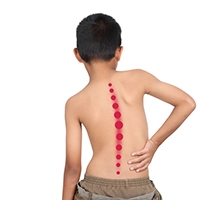
Three million adolescents are diagnosed with scoliosis each year. Although this condition can affect a person at any age, young adults are among the most frequently diagnosed. If you have a child approaching adolescence, note these important scoliosis facts so that you can recognize the signs as quickly as possible.
Symptoms of Scoliosis Can Be Quite Subtle
Don’t feel guilty if you miss the symptoms of scoliosis in your child. This condition does not always cause any pain or discomfort, and has subtle symptoms that are quite easy to miss for most parents. Summertime is known among pediatricians as the season for scoliosis cases, as seeing your son or daughter in a bathing suit often highlights any changes to their shoulders or hips.
The word scoliosis comes from the ancient Greek word meaning bending. Scoliosis symptoms include an uneven shoulder height or prominent shoulder blade, uneven hips, the head not being centered on the body, and sometimes can include irregular positioning of the arms as they hang down by a person’s sides. Look for a curve to the spine that looks like a C or an S.
Finding It Early Is Best

The earlier a diagnosis is made, the easier scoliosis is to treat. If your child’s school doesn’t do a scoliosis screening every year, ask OrthoNY to do one. The optimum time to discover scoliosis is prior to puberty and especially before large growth spurts start happening. This way, OrthoNY can form a treatment plan for your child before their spine curves further out of shape as their body continues to develop.
A small amount of spine curvature is common, but once it reaches over a 10 percent curve it is identified as a case of scoliosis.
Scoliosis Is Idiopathic
The word idiopathic means there is no known cause determined for scoliosis. There is also no way to prevent your child from developing this condition. No matter how many times you may tell your son or daughter to stand up straight, it really has no effect and the slouching does not cause scoliosis. Carrying a heavy backpack doesn’t have an influence on this condition either.
Scoliosis Is in the Genes
Scientists believe scoliosis is related to a person’s family history, meaning it is found in their genetic makeup. Even if you’re not aware of a family member who had it, it could simply be that your child is the first to show symptoms, or if previous family members had a mild case then they may have never been accurately diagnosed.
Treatment May Not Be Needed
This may come as a surprise, but only a small percentage of scoliosis cases require treatment, and that can even include physical therapy.
Only about 30% of individuals who are diagnosed with scoliosis will require a brace, as this supportive device is typically only associated with more moderate to severe situations. Times have changed and today’s braces are not only more comfortable, but they are also nearly invisible under clothes so that your child won’t feel self-conscious while wearing one. In addition, they can continue on with most of their normal activities without being hindered in any way. However, back braces are only used to maintain the curve in the spine, not to decrease it.
If Surgery Is Required, It Is Quite Successful
Only 10% of scoliosis patients will need to have surgery performed, though many can expect great results afterward. This is especially true when scoliosis is discovered early on in the person’s life. Children who have had scoliosis will grow up to lead normal happy lives free from symptomatic complications caused by scoliosis.
If you notice a curvature of your child’s spine or any of the other symptoms of scoliosis, see OrthoNY for an evaluation.
As always, if you have any further questions or would like to schedule an appointment, please call (518) 489-2663 or request an appointment online today!
